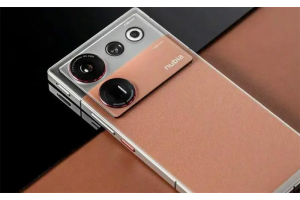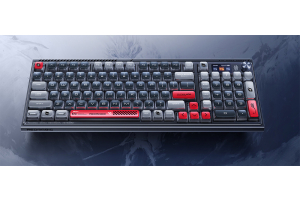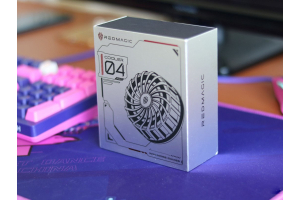RedMagic's New Gaming Phone : Powerful Flagship Chip Alongside AI!
Following Apple's unveiling of its first AI system, Apple Intelligent, at WWDC24, major smartphone brands now have their own AI directions. Typically, AI in phones acts as an "assistant," providing features like automatic article summaries, AIGC image removal/generation, and image optimization. However, in niche markets, AI can bring about entirely different changes.

The gaming phone brand Red Magic announced it will hold a new product launch event on July 4th. According to previous announcements, there will be two major new products: the Red Magic 9S Pro and Red Magic 9S Pro+ gaming phones, and the brand's first gaming laptop. More importantly, the theme of this event is "AI Evolution Beyond Gaming," marking the Red Magic 9S Pro series as "AI gaming phones" for the first time.

We are familiar with the concept of AI phones. For example, the OPPO Find X7 series and the Samsung Galaxy S24 series, which incorporate a lot of AI functions and integrate large models into the system's core architecture, can be called AI phones. However, if Red Magic aims to refine AI phones specifically for gaming, creating an experience distinct from other AI phones, it would be quite a challenge. Can Red Magic leverage AI to bring gaming phones back to the mainstream market and compete directly with various AI flagship phones?
AI Gaming Phones: Red Magic Innovates Again
As one of the first gaming phones equipped with the Snapdragon 8 Gen 3 mobile platform, the Red Magic 9 Pro series has been available for half a year. Based on Red Magic's previous update cycle, the newly released Red Magic 9S Pro series is likely a minor upgrade rather than a major overhaul.
The most significant upgrade in the Red Magic 9S Pro series is the processor, from the previous Snapdragon 8 Gen 3 to the Snapdragon 8 Gen 3 Advanced Edition. This advanced edition, which was previously exclusive to the Samsung Galaxy S24 series, is now available as a public version.
The Snapdragon 8 Gen 3 Advanced Edition retains the "1+5+2" core layout, consisting of one Cortex-X4 super core, five Cortex-A720 large cores, and two Cortex-A720 downclocked cores. The frequency range has been expanded to 365MHz to 3398MHz, allowing for more flexible scheduling and extreme performance in high-demand scenarios.
Despite these frequency adjustments, the Snapdragon 8 Gen 3 Advanced Edition does not significantly outperform the standard version, particularly when considering previous generations where the performance gap between the standard and advanced editions was minimal. Red Magic's decision to adopt the Snapdragon 8 Gen 3 Advanced Edition in its first batch is primarily due to the gaming performance scheduling needs and the foundation it lays for AI gaming features.
The core configurations of the Red Magic 9S Pro are mostly unchanged, including the BOE Q9+ display, new-generation under-display camera, ultra-thin under-display fingerprint sensor, and a dual 50-megapixel main camera setup with a 2-megapixel macro lens. Overall, the processor and AI gaming optimizations are the main highlights of this half-generation upgrade, with other peripheral improvements being minimal.
Enhancing Gaming Experience with AI
Using AI technology to optimize mobile gaming is an industry trend. As far back as 2018, OPPO introduced the AI gaming mode in its R15 series, which automatically clears background apps and allocates CPU/GPU resources for a better gaming experience.
With the rise of open-world games demanding high phone performance, such as Genshin Impact, Tower of Fantasy, and others, AI-based game optimization solutions have become widespread. For example, iQOO's super-resolution algorithm uses trained models and machine learning to improve game resolution.

Similarly, frame interpolation algorithms based on trained technologies enhance the overall frame rate of games, preventing noticeable frame rate fluctuations. Both super-resolution and frame stabilization technologies are effective primarily for popular games. For gaming phones, which need to stand out from regular flagship phones, merely excelling in popular games isn't enough. Red Magic might introduce a self-adaptive gaming model in its new RedMagicOS, recognizing frame drops and resolution issues in real-time, analyzing them, and continuously optimizing game smoothness.
However, "smoothness" is a basic requirement in the esports domain. Red Magic's audience expects much more. Considering previous attempts by game companies to integrate AI models into game characters, Red Magic might develop an AI game assistant. Like most AI assistants, it could offer game walkthroughs or tutorials to help players improve their success rates.
Besides an AI game assistant, features like one-click editing for kill highlights or exciting moments could be introduced, similar to Honor's one-click vlog function in MagicOS 8.0. However, many games already have built-in recording assistants, like Arena of Valor and League of Legends: Wild Rift.
Breaking the Mold with AI in Gaming Phones
Back in 2019, Black Shark introduced the first gaming phone, sparking rapid growth in the mobile gaming market. This led to the emergence of brands like Red Magic, iQOO, and ROG Phone, targeting this niche market.
However, gaming phones and gaming laptops differ significantly. The former struggle to achieve substantial performance breakthroughs, as flagship-level chips are dominated by MediaTek and Qualcomm. With advancements in semiconductor technology, mainstream flagship phones now offer similar or even superior performance compared to gaming phones. For instance, Apple's A-series chips and Qualcomm's Snapdragon 8 series processors have greatly improved performance, enabling regular flagship phones to run large games smoothly.

According to Counterpoint's market report, 70% of flagship phones released in 2023 are equipped with liquid cooling systems or graphene cooling technology. Flagship phones also boast impressive battery capacities and fast charging speeds, such as the Oppo Find X5 Pro with a 5000mAh battery and 80W super-fast charging.
With hardware gaps narrowing, software becomes crucial. Gaming phones typically feature custom operating systems and functions designed for gaming, like game modes and performance boost modes. However, mainstream smartphone operating systems are also evolving, adding similar functions. For example, Android's Game Mode API enhances gaming performance and stability, while iOS 16's high refresh rate support and low latency touch technology make iPhones more competitive in gaming.

AI models entering the smartphone market may provide Red Magic with a survival niche. Gaming phones can use AI technology to offer a more personalized user experience, recommending optimal game settings and configurations based on user data. AI can also learn user behavior and preferences, adjusting virtual character responses and actions in real-time, enhancing game immersion and realism.
In conclusion, whether in the mainstream or niche markets, AI presents both opportunities and challenges. Red Magic's bold move to make AI a core theme for its new products is likely to result in unique AI feature optimizations, offering mobile gaming enthusiasts a more comfortable experience. The full extent of Red Magic's AI innovations will be revealed at the July 3rd launch event.











